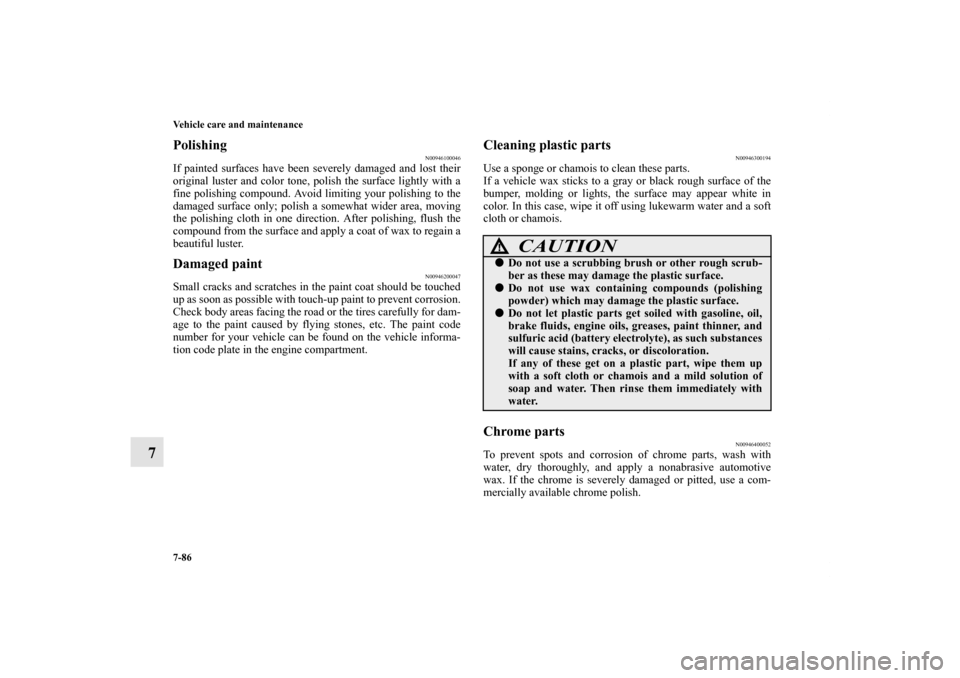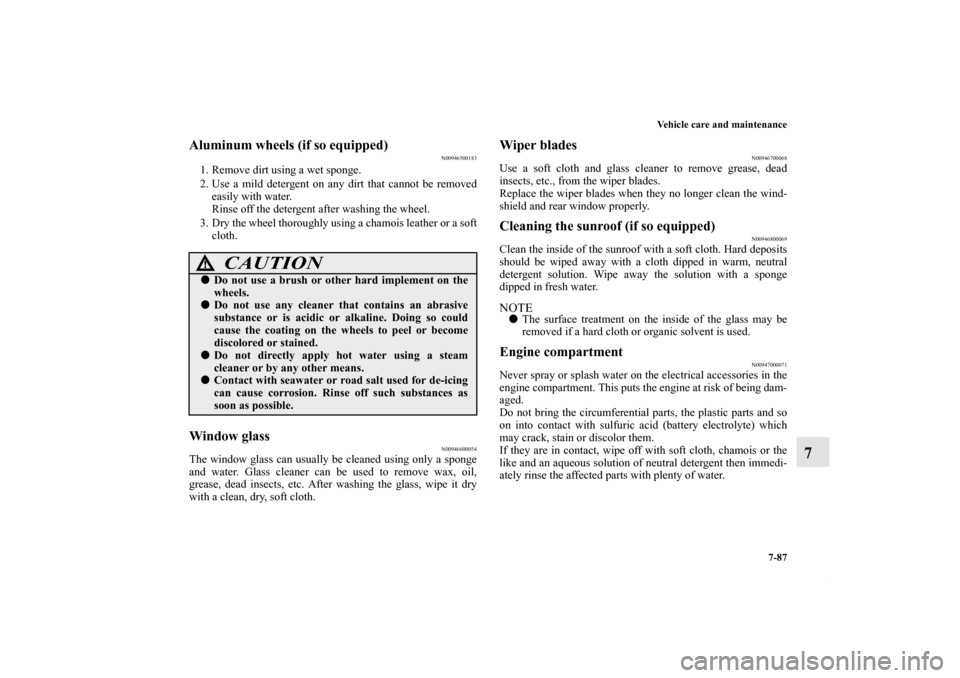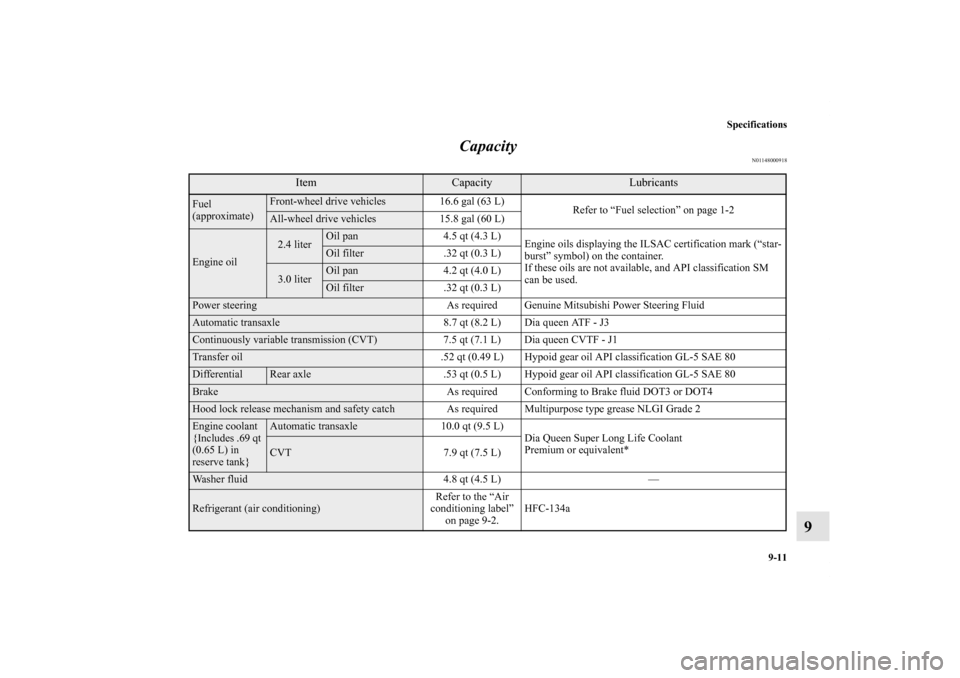Page 681 of 714

7-84 Vehicle care and maintenance
7
During cold weatherSalt and other chemicals spread on winter roads in some geo-
graphical areas can have a detrimental effect on the vehicle
underbody. You should flush the underbody with a high pres-
sure hose every time you wash the outside of your vehicle.
Take special care to remove mud or other debris which could
trap and hold salt and moisture.
After washing your vehicle, wipe off all waterdrops from the
rubber parts around the doors to prevent the doors from freez-
ing.
CAUTION
!�When washing the underside of your vehicle or the
wheels, wear a pair of gloves to protect your hands.�If your vehicle has rain sensor wipers, place the
wiper switch lever in the “OFF” position to deacti-
vate the rain sensor before washing the vehicle. Oth-
erwise, the wipers will operate in the presence of
water spray on the windshield and may get damaged
as a result.�Never spray or splash water on the electrical parts
in the engine compartment. This may damage them.
Be careful also when washing the underbody to
ensure that water does not enter the engine com-
partment.�Avoid automatic car washers that use rotating
brushes. These brushes may scratch the paint sur-
face and make it dull.
Scratches are more noticeable on darker colored
vehicles.�Some hot water washing equipment uses high pres-
sure and heat to clean your vehicle. Because hot
water can damage plastics parts and seep inside
your vehicle, make sure you do the following when
using such equipment:
• Keep the washing nozzle at least 16 inches (40 cm)
away from the vehicle body.
• When washing around the door glass, hold the
nozzle at a distance of more than 20 inches (50 cm)
and at a right angle to the glass surface.
�Make sure to do the following when using an auto-
matic car wash, with help from either this manual or
the car wash operator, to avoid damaging your vehi-
cle:
• Fold the outside rearview mirrors.
• Remove the antenna.
• Tape or remove the rear wiper arm assembly.
• If your vehicle is equipped with a rear spoiler or
roof rails, check with the car wash operator before
using the car wash.
• If your vehicle is equipped with the rain sensor
wipers, place the wiper switch lever in the “OFF”
position to deactivate the rain sensor.CAUTION
!
BK0122500US.book 84 ページ 2010年5月12日 水曜日 午前11時11分
Page 683 of 714

7-86 Vehicle care and maintenance
7
Polishing
N00946100046
If painted surfaces have been severely damaged and lost their
original luster and color tone, polish the surface lightly with a
fine polishing compound. Avoid limiting your polishing to the
damaged surface only; polish a somewhat wider area, moving
the polishing cloth in one direction. After polishing, flush the
compound from the surface and apply a coat of wax to regain a
beautiful luster.Damaged paint
N00946200047
Small cracks and scratches in the paint coat should be touched
up as soon as possible with touch-up paint to prevent corrosion.
Check body areas facing the road or the tires carefully for dam-
age to the paint caused by flying stones, etc. The paint code
number for your vehicle can be found on the vehicle informa-
tion code plate in the engine compartment.
Cleaning plastic parts
N00946300194
Use a sponge or chamois to clean these parts.
If a vehicle wax sticks to a gray or black rough surface of the
bumper, molding or lights, the surface may appear white in
color. In this case, wipe it off using lukewarm water and a soft
cloth or chamois.Chrome parts
N00946400052
To prevent spots and corrosion of chrome parts, wash with
water, dry thoroughly, and apply a nonabrasive automotive
wax. If the chrome is severely damaged or pitted, use a com-
mercially available chrome polish.
CAUTION
!�Do not use a scrubbing brush or other rough scrub-
ber as these may damage the plastic surface.�Do not use wax containing compounds (polishing
powder) which may damage the plastic surface.�Do not let plastic parts get soiled with gasoline, oil,
brake fluids, engine oils, greases, paint thinner, and
sulfuric acid (battery electrolyte), as such substances
will cause stains, cracks, or discoloration.
If any of these get on a plastic part, wipe them up
with a soft cloth or chamois and a mild solution of
soap and water. Then rinse them immediately with
water.
BK0122500US.book 86 ページ 2010年5月12日 水曜日 午前11時11分
Page 684 of 714

Vehicle care and maintenance
7-87
7
Aluminum wheels (if so equipped)
N00946500183
1. Remove dirt using a wet sponge.
2. Use a mild detergent on any dirt that cannot be removed
easily with water.
Rinse off the detergent after washing the wheel.
3. Dry the wheel thoroughly using a chamois leather or a soft
cloth.Window glass
N00946600054
The window glass can usually be cleaned using only a sponge
and water. Glass cleaner can be used to remove wax, oil,
grease, dead insects, etc. After washing the glass, wipe it dry
with a clean, dry, soft cloth.
Wiper blades
N00946700068
Use a soft cloth and glass cleaner to remove grease, dead
insects, etc., from the wiper blades.
Replace the wiper blades when they no longer clean the wind-
shield and rear window properly.Cleaning the sunroof (if so equipped)
N00946800069
Clean the inside of the sunroof with a soft cloth. Hard deposits
should be wiped away with a cloth dipped in warm, neutral
detergent solution. Wipe away the solution with a sponge
dipped in fresh water.NOTE�The surface treatment on the inside of the glass may be
removed if a hard cloth or organic solvent is used.Engine compartment
N00947000071
Never spray or splash water on the electrical accessories in the
engine compartment. This puts the engine at risk of being dam-
aged.
Do not bring the circumferential parts, the plastic parts and so
on into contact with sulfuric acid (battery electrolyte) which
may crack, stain or discolor them.
If they are in contact, wipe off with soft cloth, chamois or the
like and an aqueous solution of neutral detergent then immedi-
ately rinse the affected parts with plenty of water.
CAUTION
!�Do not use a brush or other hard implement on the
wheels.�Do not use any cleaner that contains an abrasive
substance or is acidic or alkaline. Doing so could
cause the coating on the wheels to peel or become
discolored or stained.�Do not directly apply hot water using a steam
cleaner or by any other means.�Contact with seawater or road salt used for de-icing
can cause corrosion. Rinse off such substances as
soon as possible.
BK0122500US.book 87 ページ 2010年5月12日 水曜日 午前11時11分
Page 692 of 714
9
Specifications
Vehicle labeling . . . . . . . . . . . . . . . . . . . . . . . . . . .9- 2
Vehicle dimensions . . . . . . . . . . . . . . . . . . . . . . . .9- 6
Vehicle weights . . . . . . . . . . . . . . . . . . . . . . . . . . .9- 7
Engine specifications . . . . . . . . . . . . . . . . . . . . . . .9- 9
Battery . . . . . . . . . . . . . . . . . . . . . . . . . . . . . . . . . .9- 10
Tires and wheels. . . . . . . . . . . . . . . . . . . . . . . . . . .9- 10
Capacity . . . . . . . . . . . . . . . . . . . . . . . . . . . . . . . . .9- 11
BK0122500US.book 1 ページ 2010年5月12日 水曜日 午前11時11分
Page 693 of 714
9-2 Specifications
9Vehicle labeling
N01147400625
Keep a record of the chassis number and vehicle identification
number. Such information will assist police if your vehicle is
stolen.1 - Vehicle emission control information labelThe vehicle emission control information label is affixed on the
underside of the engine hood.2 - Vehicle identification number plateThe vehicle identification number is stamped on the plate riv-
eted to the left front corner of the dashboard. It is visible from
outside of the vehicle through the windshield.3 - Air conditioning labelThe air conditioning label is affixed on the inside panel of the
engine hood.
4 - Vehicle information code plateThe vehicle information code plate is located on the front pas-
senger door sill.
BK0122500US.book 2 ページ 2010年5月12日 水曜日 午前11時11分
Page 694 of 714
Specifications
9-3
9
Chassis numberThe chassis number is stamped on the bulkhead as shown in
the illustration.
Engine serial numberThe engine serial number is stamped on the cylinder block as
shown in the illustrations.2.4 liter models
BK0122500US.book 3 ページ 2010年5月12日 水曜日 午前11時11分
Page 700 of 714
Specifications
9-9
9 Engine specifications
N01147700455
Item
2.4 liter
3.0 liter
Engine model 4B12 6B31Engine displacement 144.0 CID (2,360 cm³) 182.9 CID (2,998 cm³)No. of cylinders and cylinder arrangement 4 in line 6-V60°Bore 3.46 in (88.0 mm) 3.45 in (87.6 mm)Stroke 3.82 in (97.0 mm) 3.26 in (82.9 mm)Compression ratio 10.5Thermostat valve opening temperature 188.6 °F (87.0 °C) 179.6 °F (82.0 °C)Spark plugs
NGK DIFR5C11 ILKR7B8DENSO — SXU22HDR8
Spark plug gap .040 to .043 in (1.0 to 1.1 mm) .028 to .031 in (0.7 to 0.8 mm)Firing order 1-3-4-2 1-2-3-4-5-6
BK0122500US.book 9 ページ 2010年5月12日 水曜日 午前11時11分
Page 702 of 714

Specifications
9-11
9 Capacity
N01148000918
Item
Capacity
Lubricants
Fuel
(approximate)
Front-wheel drive vehicles 16.6 gal (63 L)
Refer to “Fuel selection” on page 1-2All-wheel drive vehicles 15.8 gal (60 L)
Engine oil
2.4 liter
Oil pan 4.5 qt (4.3 L)
Engine oils displaying the ILSAC certification mark (“star-
burst” symbol) on the container.
If these oils are not available, and API classification SM
can be used.Oil filter .32 qt (0.3 L)
3.0 liter
Oil pan 4.2 qt (4.0 L)Oil filter .32 qt (0.3 L)
Power steering As required Genuine Mitsubishi Power Steering FluidAutomatic transaxle 8.7 qt (8.2 L) Dia queen ATF - J3Continuously variable transmission (CVT) 7.5 qt (7.1 L) Dia queen CVTF - J1Transfer oil .52 qt (0.49 L) Hypoid gear oil API classification GL-5 SAE 80Differential
Rear axle .53 qt (0.5 L) Hypoid gear oil API classification GL-5 SAE 80
Brake As required Conforming to Brake fluid DOT3 or DOT4Hood lock release mechanism and safety catch As required Multipurpose type grease NLGI Grade 2Engine coolant
{Includes .69 qt
(0.65 L) in
reserve tank}
Automatic transaxle 10.0 qt (9.5 L)
Dia Queen Super Long Life Coolant
Premium or equivalent*CVT 7.9 qt (7.5 L)
Washer fluid 4.8 qt (4.5 L) —Refrigerant (air conditioning)Refer to the “Air
conditioning label”
on page 9-2.HFC-134a
BK0122500US.book 11 ページ 2010年5月12日 水曜日 午前11時11分